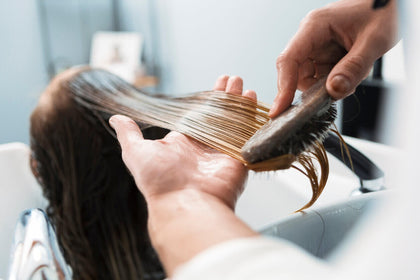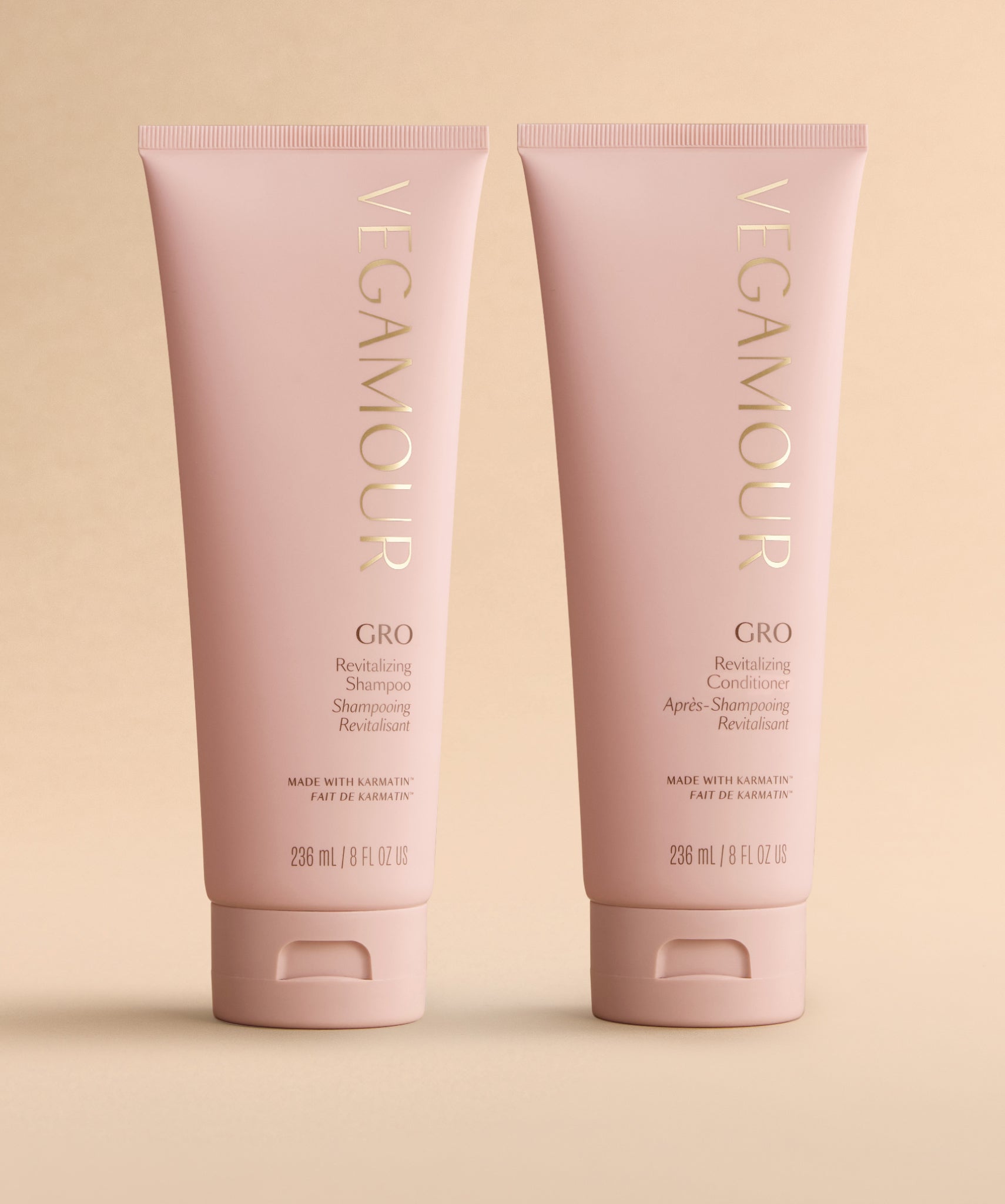Whether you want the wolf cut, unicorn cut or a classic graduated bob, the decision your hairstylist makes to cut your hair wet or dry will have a big impact on the finished style.
VEGAMOUR spoke with a hair guru to get the goods on wet versus dry hair-cutting methods and which one you should choose during your next salon trip. Plus, find out what products you should use to achieve healthier, shinier and fuller hair.
Wet Haircuts vs. Dry Haircuts
VEGAMOUR spoke with Ashley Stone Hernandez, founder and CEO of Beauty Entourage, for her expertise. Hernandez said, "As a stylist, when choosing to cut wet or dry, it can vary based on the end goal. Many times I opt to do both."
Hernandez also said, "A dry cut can customize a haircut unique to that client and based on what the hair naturally does." On the other hand, some extreme changes mean the hair needs to be wet for more control. For example, Hernandez explained that if clients desire a precision haircut or cutting a lot of length, wet cutting methods are better for cleaner sectioning and more accuracy.
It helps to know a little about the benefits of wet cutting and dry cutting techniques. Some hairstyles or types might benefit from dry cutting or vice versa. Your stylist may also use a combination of cutting hair dry for texturizing and using wet cuts for your monthly trims to achieve the desired style and maintenance of your look.
Shop: GRO Foundation Kit for Hair Wellness
Benefits of Getting a Dry Haircut
Cutting hair while dry has many benefits, such as the following:
- How the hair falls naturally is more visible.
- Strong hair patterns of movement are more visible when dry.
- Damaged areas and split ends are more easily seen on dry hair.
- It might make for a shorter appointment time or a less expensive service.
- Some texturizing requires cutting on dry hair.
- Some hairstyle shapes are easier to achieve when cutting dry hair.
Preparation for a Dry Cut
For dry cutting, the stylist will want you to part your hair where you normally do and put the hair into the most natural way you wear it each day. No water will be added for dry cutting, but there might be a detangling sesh before your haircut begins. You can always ask your stylist to shampoo afterward if you want the whole salon experience.
Shop: Madison Rae's Top VEGAMOUR Picks
Benefits of Wet Haircutting
Cutting wet hair also has the following perks:
- Wet cutting can help with precision cuts.
- Having the hair wet is great for very thick manes to condense the hair and make it easier to section.
- It allows for pre-conditioning to make the hair more manageable during cutting.
- It can give a more complete salon experience.
- It might work better on some hair types.
Preparation for a Wet Haircut
Shampoo and condition with gentle, sulfate-free products. Prep the hair with leave-in conditioners only if the extra slip is needed to smooth the hair while cutting.
Combining Methods
Your stylist may cut your hair dry, shampoo and condition and then polish the cut while your hair is still wet. They may also shampoo, condition, cut, blow dry and style, then do the precision texturizing techniques with the hair dry. This allows the stylist to work with the hair while drying and styling to identify areas that need more texture or removal of bulk or weight from the hair.
Choosing: Wet Method or Dry Method?
A cut from a professional is the best way to get a beautiful and stylish finished look. A hairstylist has the ability assess your hair's needs, acknowledge your style preferences and recommend a dry cut or wet cut. Before you head to the salon to cut your hair, check out our curated tips for making the right choice on a haircut method and technique.
Hair Cutting Techniques
Some hair-cutting techniques require dry hair, such as those that use:
- Thinning and texturizing shears and thinning techniques with hair-cutting shears
- Back-cutting texturizing
- Clipper and buzz cutting
Shaping the hair with a straight razor, however, will require the hair to be wet in order to avoid pulling or damaging the hair. Otherwise, cutting hair wet or dry is more of a choice. Of course, if the hair is very soiled, a shampooing service before your cut is best.
Types of Hair
When you choose a hair-cutting technique, consider the natural texture of the hair, which may dictate the best techniques for your hair.
Straight Hair
Straight strands can be cut wet or dry. However, this type of hair often does well with a dry cut method. This is especially true for straight-edge cuts, like a classic or graduated bob.
Fine Hair
Fine hair does well when cut dry; it allows the stylist can judge the natural weight of the hair as it hangs.
Related reading: How to Make Thin Hair Look Thicker
Coily Hair or Kinky Hair
Coily or kinky hair can be cut wet with the assistance of a wide-tooth comb or by finger-combing the hair. This type of hair also does well with a wet/dry method. The bulk of the haircut is done after shampooing and conditioning, and a quick polishing trim can be done (if needed) once the hair is dried and styled.
Hair With Uneven Curl patterns
Uneven curl patterns are more visible when dry, so this type of hair might need to be cut while dry.
Curly Hair
Curly locks can be cut wet or dry. Curl patterns often look very different when wet but can be more easily combed when wet. If this is the case, cut curly hair for more drastic cuts when wet and polish up the cut while dry. Face framing or adding bangs may be done more easily on dry hair to determine where the individual curls will lay.
Wavy Hair
Wavy tresses do great with a dry haircut. Texturizing can also be done dry to lighten the weight of the hair and bring out those natural waves.
Very Long Hair
Very long hair can be cut dry simply because it's easier to determine how the hair hangs. Plus, wet hair is really heavy, and this can make it more difficult to cut when dealing with very long hair lengths.
Hair with Visible Damage
Cutting hair that has split ends or damaged areas might do better with a dry haircut. This method can make it easier to see and remove visibly damaged hair ends and lengths.
Related Reading: Do Split Ends Stop Hair Growth?
Children's Hair
Wet cutting might be more difficult on a child if the salon doesn't have a children's shampooing station. A dry cut can be quicker and less stressful for a child or baby.
From Haircutting to Holistic Wellness — It All Matters
However you choose to shape your mane, a reputable stylist can help you decide whether wet or dry cutting will offer the best results. However, that's just one factor in helping your hair look its best. Besides the cut, it's also important to focus on steps to overall health and wellness, such as eating right, reducing stress and getting plenty of sleep. Doing so will not only help your body and mind, but it will also help you achieve optimum shine and health for your scalp and strands!
#include-related-slider#
More From VEGAMOUR
- Shop: Sulfate-Free Shampoo for Healthy Hair
- Want Bangs But Have Thin Hair? Try These Tips
- This Is How Often You Should Cut Your Hair
- Why Does Stress Cause Hair Loss?
- Check Out Shea Whitney's Healthy Hair Routine
Photo credit: Nastasic/iStock
Back



















